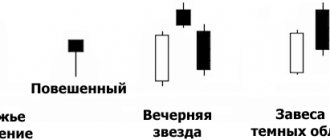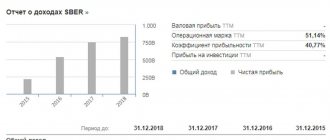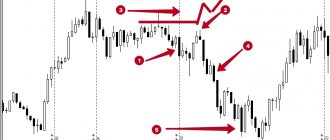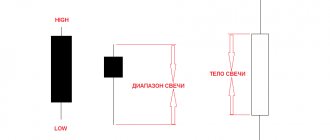— Price Action. Forex strategies without an indicator - Options for profitable strategies without indicators - Indicator without redrawing - Conclusion about indicators - Video
One type of trading is Price Action, which translates as “price movement”. Supporters of this type, of which there are more and more, use only the price and no indicators for trading. The trader reads the price movement, keeping patterns and price models in mind. Price Action has many advantages and, after some practice, can bring decent profits to the trader. Forex strategies without indicators are based on graphical patterns or patterns, the use of different types of charts, as well as candlestick analysis. They are used on medium-term time intervals. This allows you to achieve the maximum reward to risk ratio. In addition, trading using graphical models and candlestick analysis is much more exciting than waiting for an indicator signal.
Strategy for M15 and JMA from M. Yurik
The first trading strategy that we will consider was proposed back in 1998 by the famous trader M. Yurik. He is the developer of the JMA indicator, which underlies the methodology under consideration.
Setting up a trading system
Externally, the JMA indicator resembles ordinary moving average lines, but in practice this tool is more effective. It works on almost the same principle as regular moving averages, only its signals do not lag behind the price. This is the main advantage of JMA, for which many traders love it.
To search for signals, only one tool is used - the JMA indicator. Trading takes place on the M15. The strategy is best suited for the euro/dollar currency pair, as this is where it brings the greatest income. You can experiment with other currencies, but the amount of total profit in this case may be sharply reduced.
It is better to trade between 5:30 am and 2:00 pm Moscow time. According to tests, it is during this period that the vehicle gives the most accurate and high-quality signals. Since the chart timeframe is quite low, it is necessary to simultaneously monitor the economic calendar. If you plan to release any important news marked by two or three bullish heads, then there is no need to trade 30 minutes before and after the publication time.
To work, add two JMA indicators with different settings to the chart. The colors of the lines and the values of the “Len” parameter will be different:
- Make the first line red and set its “Len” to 40.
- Color the second line yellow and set the “Len” value to 80.
Timeframe – M15.
How to open trades
This technique is very simple, so it is often used by beginners. The indicator signals are clear and easily distinguishable on the chart. A sell transaction can be opened at the moment when the red line has broken through the yellow line from top to bottom. As soon as the candle where this breakout occurred closes, you can immediately enter the market. To limit losses in the event of a false signal, set a stop loss at the nearest high.
A sell trade should be closed at the moment when the curves intersect in the opposite direction, that is, the yellow moving average will break through the red one from top to bottom. If desired, you can set a take profit in an amount equal to at least two stop losses.
A buy deal is opened according to the following rules:
- The red curve broke through the yellow one from bottom to top.
- As soon as the signal candle has closed, you can place a Buy order.
- We set the stop loss for the transaction at the nearest minimum.
- You can close a deal using a take profit, which should be at least twice the stop loss, or manually when the lines cross in the opposite direction.
To filter out false signals, you can use the chart of the higher time frame – H1. If the trends in the working and senior TF coincide, then you can open a deal. If the trend of the senior chart contradicts the moving average signal on the working time frame, then there is no need to open a deal.
Recommendations for successful trading
To make trading successful, follow these simple recommendations:
- When a signal is received between 00.00 am and 09.00 am Moscow time, the order should be opened only after the price rolls back a little. However, remember that the size of such a rollback should not be more than fifteen points. If the rollback exceeds this distance, then we skip entering the market altogether.
- If the signal appeared after 09.00 am Moscow time, then the order should be opened only if the signal candle (the one at which the moving averages crossed) closed no further than 25 points from the indicator line point. If this condition is not met, there is no need to open a transaction.
- If a signal appears during a flat, there is no need to open a trade. You need to wait until at least 7 more candles close on the chart. If at this time the lines do not intersect in the opposite direction, then you can enter the position.
- A signal is considered ideal when the lines intersect at a distance of less than 10 points from the current price value. In this case, you don’t have to wait until the signal candle closes, but immediately enter the market.
This technique has existed for decades and has helped hundreds of traders make money. Of course, like any other system, it can sometimes give misfires and false signals, but in general, the profit will still more than cover the losses.
Let's sum it up
Well, let’s slowly summarize, I promised you at the end of this publication I will explain why I don’t like trading binary options. The answer will be very simple, the fact is that the Forex market is more professional and creates many more opportunities for earning money, and all this can be very easily proven, which is what I will do now.
One of the main factors of successful trading is the correct management of your risks. I hope you have already heard that any professional transaction on the market must meet a risk-to-reward ratio of at least one to two. If we take binary options, then the level of profit is determined by the brokerage company and, as a rule, it is at the level of sixty to ninety percent. Even if we take the maximum figure of ninety percent, then in order to be even “at home”, you need to win fifty-four or even fifty-five transactions out of a hundred. As you can see, initially the advantage is no longer on your side. Well, if we compare everything with the Forex market, then working according to the one-to-two system, in order to be at the break-even level, you need to close only thirty-three transactions out of a hundred, which is twenty less than in the case of “binaries”, That’s actually the whole point of why I switched to Forex.
On this excellent note we will end today’s publication; I hope you will think about the results and draw the right conclusions. All that remains is to wish you success in all your endeavors and, of course, continue to improve yourself. Don't forget to put stars at the end of the publication and, of course, comment on our posts.
M15 Forex strategy based on RSI and Stochastic
This trading system is based on only two indicators - stochastics and Relative Strength Index. Both tools are built into the terminal and do not require separate installation.
Vehicle settings
You can work with any assets whose charts do not show a flat. You can use both major and exotic pairs, or cryptocurrency. In our example, we will consider trading the Eur/Jpy pair.
Analysis of price movements will be carried out on two TFs – M15 (working) and H1 (senior). We will use the latter to filter signals.
On the m15 chart, add a stochastic with settings 5, 3 and 3. Set the levels to 20 (oversold) and 80 (overbought).
On the H1 chart, add the RSI indicator with a period equal to fourteen candles. In addition to the standard levels, add one more in the settings - with a value of 50. This will be the central (balance) line.
How to trade using TS correctly
Market analysis takes place in two stages. First, the trader switches to the hourly chart and waits for the RSI to give a buy or sell signal. Next, when the signal is received, the player switches to a fifteen-minute time frame and waits for exactly the same signal from the stochastic. After this, a deal is opened.
Buy signals will be as follows:
- On the H1 chart, the RSI should leave the oversold zone, breaking through the lower level of 30 from the bottom up. The second signal option is when the RSI line has broken through the balance line from the bottom up.
- On the M15 chart, Stochastic left the oversold zone, breaking through the 20 mark from the bottom up.
As soon as the signal candle closes, you can place a new Buy order. Sl is set at 20 points. TP is equal to 2.5*SL.
The sell signals will be opposite:
- On the four-hour chart, the RSI left the overbought zone, breaking through the 70 mark from top to bottom, or crossed the level of 50 (also from top to bottom).
- On the fifteen-minute chart, the stochastic left the overbought zone, breaking through the 80 mark from top to bottom.
We place a sell order only after the signal candle closes. Place the order on the M15 chart. SL is equal to 20 points, and TP is 50 points.
When trading using this strategy, you can make a daily profit of about 8-10% of the deposit amount.
What are the benefits of 15-minute timeframes?
Many traders prefer to trade at a moderate pace, thinking about each trade for at least 30 minutes. This is enough time to evaluate the working and senior charts, look for candlestick patterns or other important signals, and also make a decision about entering the market. Graph M15 fits this requirement perfectly. When working with it, the trader has enough time to think about each transaction.
Since 96 candles are formed on the M15 chart during one trading day, the trader has the opportunity to find not one, but several points to enter the market.
Trading on the 15-minute timeframe belongs to the intraday group. Its second name is intraday. Due to the fact that positions are opened and closed within one day, the trader does not have to spend money on swap - commissions for transferring transactions from one trading day to another. All you need is to choose the right time frame for intraday trading and choose a good strategy.
Strategy on moving averages for m15
This is one of the simplest trading techniques for a fifteen minute chart. It is based on the EMA indicator - this is an exponential moving average line. You can install EMA on the chart from the “Insert” menu of the Meta Trader terminal.
What tools are needed?
To trade, add three exponential curves to your chart with different settings:
- Color EMA 1 red and set the period to 6 bars.
- EMA 2 should be yellow and its period should be 12 candles.
- For EMA 3, set the color to green and the period to 21 bars.
The screenshot above shows an example of how the chart should look after installing all the tools. On the chart you can see that a signal has been received to purchase the currency. The point where a new position could be opened is marked with a dark blue rectangle. The buy signal came at the moment when the bright red line EMA 1 crossed EMA 2 and EMA 3 from bottom to top. As a result, the lines were arranged in the following order (from top to bottom): EMA 1 => EMA 2 => EMA 3. As can be seen on the chart, immediately after this signal, an upward trend really began to develop on the chart.
When the signal candle closes, you can place a new order. To protect your deposit, set a stop loss a few pips further than the local minimum. Take Profit must exceed SL at least twice.
In the chart above, the SL setting point was indicated by the red line and TP by the blue line.
A sell transaction is opened according to a similar pattern, but the signal will look slightly different. This time, the bright green EMA 3 should be located above all. The bright yellow curve will be in the middle, and EMA 1 will be the lowest. When the bright green moving average breaks through the yellow and red ones and rises above all the lines, wait until the current candle closes and open a new sell order. We set SL a few points further than the local maximum. Take profit should be twice the stop loss.
To filter signals, you can use a chart of a higher time frame, or any other indicator, for example, Stochastic. When using a senior TF, follow the trend. If the trend on the older TF coincides with the direction of the signal, then you can open a deal. If the signal contradicts the trend on the older TF, then it is better to ignore the signal.
We also recommend testing the MA MTF indicator. This is a multi-timeframe tool based on regular moving average signals.
Strategy for the M15 chart based on CCI and Stochastic
This strategy is called “Runner”. The developers of this strategy advise using it as an additional, and not the main vehicle. Despite the fact that the technique was created specifically for a fifteen-minute TF, it takes very little time. TS gives a small but stable profit and is suitable even for beginners.
During testing, the technique showed good results. In three months it brought about 500 points of profit, that is, about 160 points per month. This is not so much, but the strategy took almost no time.
It is better to trade on major pairs, for example, Eur/Usd. Chart timeframe – M15.
To search for signals, only two indicators are used:
- CCI, levels +100 and -100, period – 14 candles.
- Stochastic, levels 80 and 20, settings – 8, 3 and 3.
How to open a buy trade
We open a buy deal using the following algorithm:
- We open the chart at 8:00 Moscow time. You should not trade before this time.
- We are waiting for the moment when the CCI indicator drops below the -100 level.
- Next, the CCI indicator should rise above the -100 level, breaking through it in the opposite direction (from bottom to top).
- The signal and main stochastic line crossed each other. The main line is in the oversold zone or has just left it, breaking through level 20 from the bottom up.
If both indicators agree on the signals, you can open a new order. At the same time, make sure that the price at the time of opening the transaction has passed no more than half the distance of the previous day. If this distance has already been passed, then it is better not to open an order.
Sl for the transaction is set at a distance of 25 points. After the price passes this distance, it moves the order to breakeven, moving the stop loss following the chart.
The deal can be closed in several ways:
- Manually, when the stochastic reaches level 80.
- By take profit, setting it in the amount of 45 to 100 points, depending on how volatile the market is.
- Follow the trailing stop with a small step.
Important! If the range of the past trading day is less than 35 points, then the signals are not taken into account. Trading on this day is not recommended.
All trades must be closed at the end of the current trading day. Transactions are not transferred to a new day.
How to open a sell trade
As in the case of purchases, you should start searching for signals no earlier than 8 a.m. Moscow time.
The signals for opening a Sell trade will be as follows:
- The CCI oscillator entered the overbought zone, its line rose above the +100 level.
- Next, we wait for the CCI to break through the same level from top to bottom and leave the extreme zone.
- At the moment when the CCI fell below +100, the stochastic oscillator should either be in the overbought zone (above the 80 level) or just leave it.
If both signals correspond to the rules described above, then we open a sell transaction. It is important that at the time of concluding the transaction the price does not exceed half of the range of the previous day. If the distance has already been passed, then we do not open the deal.
We place an order to protect the deposit, retreating 25 points. As soon as the price passes this distance, we move the SL after it, moving the transaction to breakeven.
You can close a trade manually, using take profit or trailing stop. If the day has come to an end and there are still active transactions, they should be closed manually. Transactions are not carried over to a new day.
We also recommend testing one of the modifications of the classic CCI - the Woodies CCI indicator and its signals.
Volume accumulation
This sideways movement on the chart is interpreted in different ways. Called a channel, flat or volume accumulation. According to the understanding of market mechanics, this is still an accumulation of volume. In any fast or slow trend movement, there is a stop and a sideways movement. If on large time frames this movement consists of several points, then on small time frames it is seen as a protracted flat.
Let us explain why this happens: for the movement of any trend, fuel is needed, that is, the volume necessary for the sale. When this volume is traded, it ends and it is necessary to accumulate it again in order to move the price further. Therefore, the price is in a side corridor - more and more traders are entering into transactions along the trend in anticipation of further movement.
This situation is also a trading situation and a strategy can and should be built on it. Unlike a trend, in volumetric accumulation, strategies without indicators for binary options allow the trader to trade in both directions. This situation looks like the picture above.
To build a volumetric accumulation channel, it is necessary to draw a support line along the lows, and a resistance line along the highs. This also applies to the rule of two touches to determine support and resistance and a third touch to open a trade.
When the support line is broken in a downtrend, it acquires the status of resistance and further transactions can be made from it. With an uptrend it's the opposite. As a result of the breakdown, the resistance line becomes a support line and provides opportunities for opening trades.
Trading strategy for m5 + m15 strategy
And finally, let’s look at another trading technique based on parabolic and Makdi signals. Both of these tools are already built into the terminal; all you have to do is add them to the chart.
The chart is analyzed for two timeframes – M5 and M15. The main one here will be not a fifteen-minute, but a five-minute timeframe. It is on it that all transactions will be opened. M15 is used to filter signals in the direction of the main trend.
Indicators should be added to both charts. You don't have to change the settings.
Important! To open a new deal, the signals of both indicators must be directed in the same direction, and the trends on the lower and higher timeframes must coincide.
A buy deal is opened as follows:
- We switch to M15 and wait for the Makdi histogram to rise above the zero line and for the parabolic to move under the chart candles.
- We switch to the five-minute chart and wait for exactly the same signals.
- When the indicator readings on M5 and M15 are identical to each other, open a new Buy deal.
Important! Before opening a trade, check the M15 chart again. Indicators should still signal an uptrend. If the situation has changed, then there is no need to open a deal.
We open a sell order using a similar scheme:
- We switch to M15 and wait for the indicators to give a signal to lower the price. McD should fall below zero and the parabolic should rise above the chart candle.
- We turn on the M5 chart and wait for exactly the same signals.
- When the indicators on M5 also confirm the price drop, we open a sell trade.
To protect your account, use a stop loss. It is placed behind a local maximum (for a sell order) or a local minimum (for a buy order). You can close a trade manually when any of the indicators gives an opposite signal.
Strategies for M15 are suitable for intraday short-term trading. With their help, you can quickly increase your deposit, practice different trading techniques, learn to analyze and “see” the market. We recommend that you practice these techniques first on a demo account, and only after that start real trading.
We also recommend testing the Through Channel strategy, based on the signals of the Bollinger Bands indicator.
Watch an additional video on the topic of the material - Rules for entering the market using the M15 strategy
Previous
Macd + Stochastic strategies for Forex
Next
Adverza tactics: full description and instructions
I recommend reading:
- Stable trading systems for the Forex market
- Trend strategies for Forex
- Large time frame in Forex and BO: indicators and strategies
- Weekly Forex strategies: chart analysis and signals
- Medium-term Forex strategies: pros and cons,…
- Forex strategies for H1: Puria method, Fork, Snake and others
- WPR (%R) indicator: signal types, description and strategies
- Relative strength index - description and application strategies
- Fisher indicator, setup and strategies…
- Bill Williams' Alligator indicator and strategies...
- Trading against the trend: strategies and rules for opening trades
- What is swing trading, strategies, entry points and...
- Forex volatility indicators
Why trade without indicators?
Newcomers to binary options trading are often looking for the very “Grail” of trading. Basically, it is an ideal indicator to help traders trade with virtually no losses. But the main problem of any indicator is the lag in indicators. This happens due to the fact that the entire process of analyzing the indicator is based on mathematical calculations, and calculations take time.
Today we will introduce you to one of the best indicators of both the Forex market and options. This indicator is called price. As you know, the price is based on many factors. These factors are individual for a particular asset. But the indicator makes an assessment of the price movement based on its current position and volumes in the market. Then why use a lagging instrument if the price position is an indicator?
Based only on price indicators, you can build an almost ideal trading strategy without indicators. It will be based on technical analysis of the market, and implemented using prices and graphical tools offered by any option terminals, as well as fundamental indicators that affect the price of the asset. Next, we will talk about popular strategies that can give good profit indicators in the options market.











